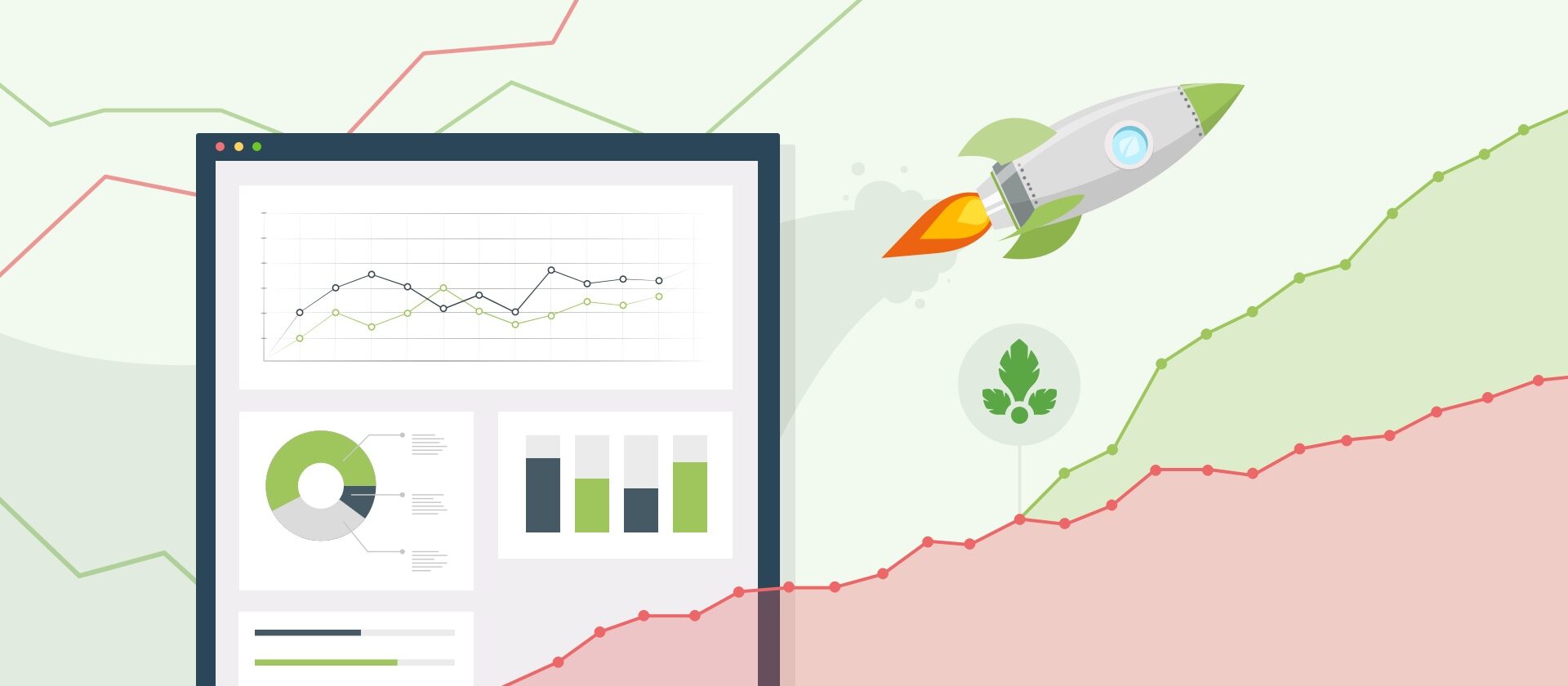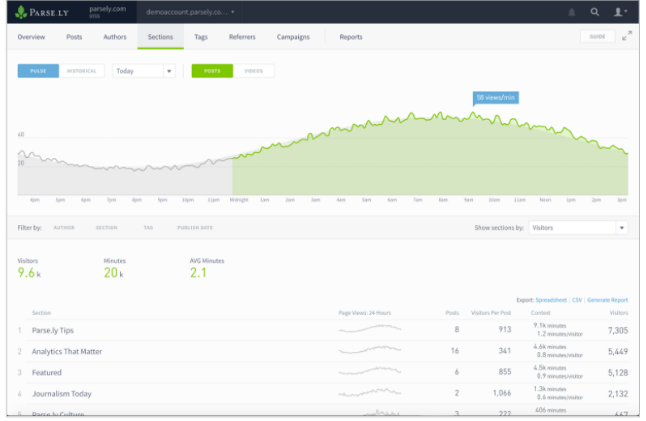Data-Driven Content: 7 Steps for a data based Content Strategy

Content marketing is a field that primarily attracts creative minds, often from related disciplines where the focus is on creating appealing content, such as journalism. The data behind the content is rarely considered. However, successful content is a mix of data and creativity. Due to competition increasing daily, experience and gut feeling are no longer enough.
Definition: What is data-driven content marketing?
As the name implies, data-driven content marketing is about marketing guided by data. Data-driven content is the result of marketing strategies in which every step and decision is based on insights from data analysis. Right from the content conception, the data determines which topics are best to target. Then during creation, content analytics tools come into play. After publication, success is measured, and depending on the data, content is optimized, deleted, or upgraded.
Why is Data-Driven Content Marketing so important?
More and more companies realize the potential of content marketing and invest accordingly. The more competitors, the higher the content quality required to survive in search engines. Above all, the planning of the content strategy should be data-driven. Marketers often try to reach the largest possible audience. However, content that is precisely targeted to a specific group is more successful.. So before the content itself is created, buyer personas should be analyzed, and it should be determined which questions they want answered on which channels.
If you only plan content based on intuition, you will most likely sink time and resources into projects without a demand. Only with the right tools and skillful evaluation can the market be correctly assessed.
Even after publication, we should continue to think data-driven. Find out what kind of content went particularly well, which channels still have more potential, and where there is room for optimization. Data often shows potentials that neither you nor the competitors had in mind.
7 Factors for a Data-Driven Content Strategy
What makes a content strategy data-driven? We have summarized seven essential steps and the most important tools for their implementation.
Audience analytics and buyer personas
Understanding the audience in detail is key to communicating appropriately. This includes demographic factors such as age, gender, and income. Do users tend to visit the site on mobile or desktop? What channels are potential customers on, and what content format appeals to them? Certain groups are more likely to be found in forums, while others interact more with video formats on YouTube.
Based on the data, buyer personas need to be created. It is particularly important to work out the problems of this target group. What are the uncertainties, and where do people get stuck? Content should then specifically address these questions and show how the products can solve them.
Definition of goals and key performance indicators
At this point, it’s clear what the audience is looking for. Now it’s time to determine what content marketing goals will work for the business. Content goals should also be aligned with the targeted buyer personas.
Are you looking to drive traffic? Is the goal to gain exposure and get the brand’s name in the minds of as many people as possible? Or does the business want to strengthen existing customer relationships and build brand trust with quality content? Maybe there already is high traffic, but it isn’t having the desired effect on sales. If so, content that drives conversions and leads should be created.
Part of the data-driven content strategy is to monitor success constantly. We explain the most important metrics in our content marketing KPIs post. . Depending on the content marketing goal, the channel used, and content format, there are different KPIs to track. The essential goal is that visitors also interact with the content, preferably across multiple touchpoints and over longer periods. In addition to pure traffic metrics, such as impressions or unique pageviews, it’s also important to keep an eye on engagement rates, times-on-page, or pages-per-session. There are various tools for measuring content metrics. We have summarized them in detail in our post about web analytics tools.
Analysis of the own content: Content Audit
It is now clear what users are looking for and what the business is targeting with content marketing. Now it’s time to determine the current status. Are there already articles doing very well? Are there certain topics in which it appears easy to rank in Google? Which authors and content formats are popular, and which are less so?
Poorly performing articles should either be deleted or optimized. Domain authority decreases in the long run with a lot of content that Google doesn’t like. Also, search engines only have a certain crawl budget reserved per website. There will also be content that used to do well but is now outdated. Try to modernize these posts. Other posts are evergreens and have been generating traffic for a long time. These should be repeated and published on all channels.
If certain topics are doing particularly well, offer more in-depth content in these areas. The domain probably has a high reputation with search engines and users for these topics. It is easy to identify the most successful topics in the “Top Sections” and “Top Tags” report with Parse.ly. Further reports filter which posts and authors perform best across all channels.

Market and competitor analysis
This is where traditional keyword research comes into play. Depending on the company’s strengths and market demand, it should be determined which keywords it wants to rank. For head keywords with a lot of traffic, content should be more general and detailed. Equally important is to aim for long-tail keywords: These are longer terms with lower search volumes and less competition.
There are many tools available to help determine the search volume and competitive intensity of specific keywords. Available for free would be, e.g., Google Trends. However, this only provides data on terms with high search volumes. More precise data can be found with specialized tools like SemRush.
The next step is to examine the competition. Are there certain keywords that competitors are targeting in particular? On which formats and channels do industry leaders have gaps that your product range can fill? Perhaps some keywords involve so many strong competitors that resources would be better spent on other targets. Also, identify which terms are getting a lot of paid ads, and whether that’s a good fit for your content strategy.
Data-Driven Content Planning
Data should be used as inspiration. Sometimes it reveals new topics users are interested in at the moment.
Anyone offering an on-site search function should also evaluate the results. Maybe users are searching for keywords on the site for which there is no content yet. The analysis of the on-site search function can be found in Google Analytics under “Behavior”>”Site Search.”
Further inspiration for possible keywords can be found by examining which trends the target group is currently following. Google Trends has a solution for this as well. In “Trending Searches,” it is possible to filter what is being searched for by country.
Data-based content planning also includes determining, even before the first word is written, which channel the content will later be distributed on. The acquisition reports of the common content analytics tools show exactly where content is doing particularly well. For example, in Google Analytics “User Flow,” shows from which platforms most visitors come to the company website. Determining which channel to use depends on the preferences of the buyer personas and the respective content format.
Data-based content creation
Now it’s time for the actual content creation. Again, this needs to be data-driven, especially to stand out in the search engines. Nowadays, a successful post needs flawless SEO. Everything has to be spot on, from loading speed over keyword density to alt tags.
There are several tools and practices to ensure that all relevant terms appear frequently and properly placed in the content. The Yoast SEO WordPress plugin, for example, shows exactly how often a target keyword is missing in a post.
An even more detailed procedure is possible with the wd-idf analysis. Here, SEO tools, such as Ryte or Termlabs.io, take their cue from posts that already rank for a keyword. The tools compare your content with the already successful content for that keyword and show missing keywords.
The data also makes a clear statement on article length. Longer content clearly took over Google SERPs in recent years. According to studies, posts with around 2000 characters have the best chances. Long- form content can address multiple questions in one post and directly educate about different topics and their subcategories. Users do not have to click on further content for definitions or questions.
Data-driven content optimization
This is where things come full circle. After publishing, it’s back to collecting and analyzing user interaction data. As the amount of data available increases over time, it also becomes easier to optimize content effectively and in detail. A/B tests, for example, require large amounts of data but then often provide valuable insights.
Customer behavior and the market are constantly evolving. Content that was successful a year ago may not be so now. A data-driven content strategy is accompanied by regular reporting. Google Data Studio, for example, is ideal for visually appealing and understandable reports.
Short-term trends often emerge that can be identified directly from user behavior. For example, sudden extreme changes in metrics such as bounce rates, Google rankings, or dwell times can indicate significant problems with the website’s content. In Google Analytics or Parse.ly, you can set up alerts for self-determined cases and thus be notified immediately of significant developments.
Creativity and Big Data
Data should guide the direction of a content strategy and facilitate content creation. It is important to find the right mix between human elements, creativity, and Big Data. Companies that go too data-driven will lose authenticity and, therefore, the reader.
Setting up a data-driven content strategy can be challenging. Contact our content analytics experts for more helpin implementing the content analytics tools you need.